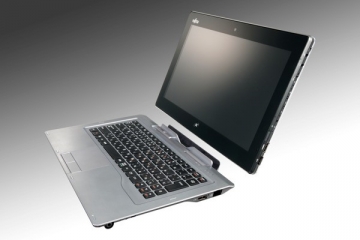Tablets in the Classroom: Where are the Hybrids?*
Could the Fujitsu's Stylistic Q702 be the Ultimate Computer for Education?
 (The Q) has the powers of a Tablet PC, but the screen can be removed from the keyboard, enabling even greater flexibility without sacrificing power and productivity.
(The Q) has the powers of a Tablet PC, but the screen can be removed from the keyboard, enabling even greater flexibility without sacrificing power and productivity.

Over the last few years at Cincinnati Country Day, we have seen enormous gains in the transformative uses of technology, sometimes thanks to an innovative culture, sometimes thanks to innovative hardware. Nearly a decade ago, we made the shift to Tablet PCs because of the flexibility they provide in the teaching and learning process. We like to use the phrase “no constraints.” They are productivity powerhouses (full Windows OS in a robust Windows network) when students and faculty need to get work done. They are creativity tools thanks to the powers of Wacom active digitizers and digital ink. They are collaborative devices as well, enabling rapid sharing of work and ideas in programs such as DyKnow and Microsoft OneNote. For us, there is no better device than a Tablet PC.
When I went to ISTE in San Diego this summer, I visited my friends at the Fujitsu booth. They had a prototype of a device we’ve been wanting for years. It had all of the powers of a Tablet PC, but the screen could be removed from the keyboard, enabling even greater flexibility without sacrificing power and productivity. Recently, we received the first of our own batch of Fujitsu Stylistic Q 702s (aka “the Q”). Approximately 200 more machines will be arriving in a few weeks, and we’re really excited about the possibilities this device (in our culture) will create. A few highlights:
- Intel® Core i5 Processor
Games and allowing a high level of multi-tasking)
- Ships with Windows 7
we will upgrade to Windows 8 as we image machines in two weeks; this will enable even greater multi-touch functionality and ease of use
- Speedy Graphics
- 128 GB Solid State Hard Drive
(fewer data issues, quicker startup and wake from hibernation)
- Full array of ports
(USB, USB 3.0, Full HDMI, VGA; this enables greater flexibility with connecting to displays and peripherals)
- The keyboard/docking station battery.
The keyboard has a build in battery in it that is used first if the slate is docked. We are not making the keyboard optional.
- Great protection
I’m excited as a teacher and am looking forward to doing feedback and assessment on the slate in the comforts of my sofa (or office chair). I’m excited about how the device will make me even more mobile in the classroom, encouraging even more “management by walking around” (Did I mention that we have wireless projectors in each classroom, so I can project and analyze student work while moving around the room already!). I’m excited that handwriting and annotating texts will be even more robust than with current tablets (the view of the “paper” in OneNote while writing is incredible; the screen looks more like paper than it ever has!). I’m excited, too, because my own daughter will benefit from this device, as she is fifth-grader this year. She’ll have at her fingertips the most powerful and flexible computing device in the world. It’s a great time to be alive!
Robert Baker, about whom I’ve blogged, created a sample video for parents of fifth graders and students new to our school. Because we typically roll machines out in August, we wanted to be sure to be proactive about keeping families looped in to the rollout process. You can get a good glimpse of the Q702 and all it offers in the video. A link to the video is below.
*NB: I retitled this post after seeing a fifth-grade parent just moments ago who asked, emphatically, “Where are the hybrids?!?!” The excitement at Country Day is palpable this year!
